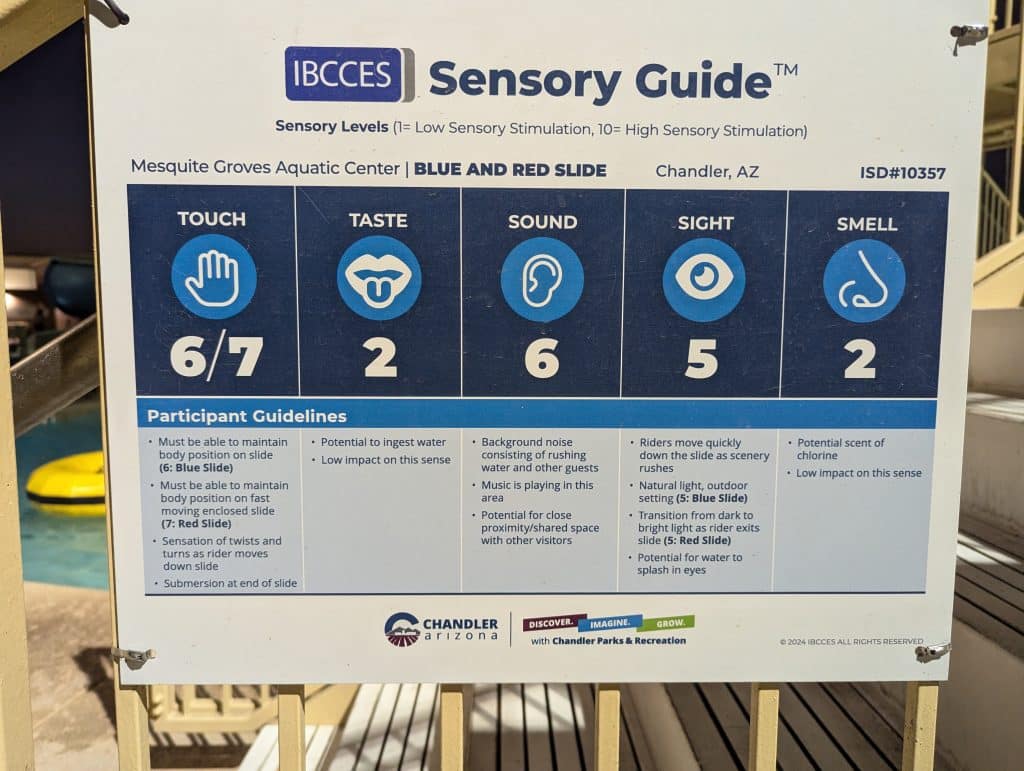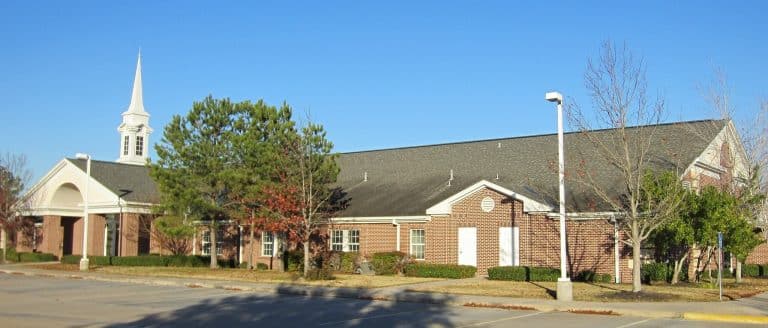National Disability Independence Day celebrates the anniversary of the Americans with Disabilities Act in 1990, an umbrella that has led to posted signs like this one I saw while at the swimming pool with my kids:

These signs are showing up more often and I have no complaints. It’s helpful to know what to expect, both for myself and my kids, one of whom is highly sensitive to sound in new environments. It’s helpful to prepare what we’ll need to manage the environment, like noise cancelling headphones. It’s good to have all the information before we enter the space. Sometimes it means saying no to an environment that just won’t work for us.
What if we were to create informative accessibility signs about our church buildings?
Though church buildings are under no legal compulsion to be ADA compliant, outside of state or local building codes, our emphasis on the doctrine of personal agency suggest that inclusivity and accessibility should be a priority.
Are church buildings places where people with chronic mental, physical, or emotional conditions can independently participate, contribute, thrive?
Consider some examples of disabilities covered by the ADA that include:
- Cancer
- Diabetes
- Post-traumatic stress disorder
- HIV
- Autism
- Cerebral palsy
- Deafness or hearing loss
- Blindness or low vision
- Epilepsy
- Mobility disabilities such as those requiring the use of a wheelchair, walker, or cane
- Intellectual disabilities
- Major depressive disorder
- Traumatic brain injury
I know I tend to myopically think of ADA in terms of wheelchair ramps and braille by the bathroom, but this list is far more encompassing and offers a call to really consider how and when our church buildings foster personal agency and full participation for all, and when they don’t.
The Front Doors
Does your building have heavy doors? Double doors? Multiple doors and a foyer? How wide are the doors? Do the doors have automatic openers?
How many doors does a person have to navigate to get to the bathroom? The cultural hall?
If you had a neurological condition with low grip and strength, would the doors present a challenge? What if you had a sight impairment or used a walker?
But wait, you might say. There’s a nice young man stationed at the main door, ready to open it, and there’s always someone in the building on Sunday to help open doors. Isn’t that a blessed act of service?
Well yes, it is an act of service, but it’s also a dependence. The door opener cannot always be there, but a person needing the independence and personal agency to enter and navigate the building will always exist.
The Hallways
Next look down the hallways. How’s the lighting? The wall texture? The width? If you had autism or ADHD, would these spaces present any extra challenges?
Is there somewhere for someone who needs low sensory environments to go? Is it a random room or closet or the nursery rather than a dedicated or intentionally designed room?
I have watched one special needs child in my ward beg to leave the building. His sensory needs tell him no, this isn’t a place that works for him.
The Chapel
Look at that walk up to the podium. Is it stairs?
I have never found a more symbolically significant message about who is truly welcome than the fact that the walk up to the literal podium where anyone should theoretically have a voice requires the ability to navigate stairs.
Consider the chairs or pews in the chapel. What’s the texture of the fabric? Are they hard or soft seats? What’s the aisle space look like?
While visiting a ward recently, I watched a lovely elderly woman in her wheelchair park herself up in the front row aisle, blocking the walkway. Technically, she had a designated short pew at the back of the chapel, but it was already occupied and, perhaps, she just wanted to sit in the front. Why shouldn’t she sit in the front if she wants to?
There’s no feasible way for this wise woman to speak from the podium. Someone would have to be willing (and able) to run a microphone to an awkwardly unofficial spot at the front of the chapel for her to speak. How could she possibly and impulsively simply want to speak during a testimony meeting?
How would a deaf person participate in sacrament? A person with PTSD?
My home ward has two deaf women and, while I love that volunteers in the ward learned ASL and translate in all meetings, I wonder if any other ward could be so accommodating if those lovely ladies traveled for a week. What happens when the translators are sick? What if the translators move or decide to cease attending?
I once visited a brand new branch building in the small town of a college roommate. They were delighted to finally have a building. Instead of an organ, the building featured an electric piano with the ability to play hymns accurately while one person kept the rhythm by hitting the same key in time with the song.
The piano was designed intentionally to function independently of a competent pianist. The small branch might not have anyone available.
Has the same care and attention been built into our buildings to ensure that any patrons can enter and be accommodated? To be independent? Given our vast coffers, correlated buildings, and wi-fi enabled buildings, it seems like something could be done.
While I’m thinking about wards being designed to let people participate in their own way and according to their own needs, does your ward still use a Zoom or livestream link? Is it accessible to sight and hearing impairments?
If you could give a rating of your ward building or build the informative sign that should be under “visitors welcome” at the front entrance, perhaps based on your own experience with your chronic conditions, what fine print would you add?
On this anniversary of the signing of Americans with Disabilities Act, while celebrating all that has been done so far, perhaps there’s good work to be done in our church buildings. I’d like to hear your experiences.
Cover photo from Wikimedia Commons










13 Responses
Our building has a ramp to the podium, but it requires a pretty narrow turn radius at the top that is difficult for larger chairs to navigate.
For the first five or more years in the building, there were two fake trees on the podium, one by the sacrament prep area, and the other AT THE TOP OF THE RAMP, to make them look symmetrical. I had two women in wheelchairs who sang in the choir when I was leading, and since we were often there early to practice, I would go and move that fake tree every Sunday. Often, I would move it into the foyer to try to find it a new place to live. Inevitably, it was back the next Sunday. I mentioned it a few times to my bishop, but we were one of four congregations in the building, one of which wasn’t even in the same stake. Communication never seemed to happen. Then a few years ago, the fake tree finally disappeared for good. Did someone “disappear” it, I wonder?
Such a simple fix and yet why does it take vigilante action to make it happen!
I’m so glad one ward building has a ramp. I have never observed a building using anything but stairs, and it is so fundamentally antithetical to the gospel.
I think our stake building was retrofitted for a ramp. It zig zags in front of the podium. It takes a lot of space and distances the speaker from the congregation more, but it works.
Ever since my mom lost her ability to walk (before passing away on New Year’s Day this year), I’ve become hyper aware of how hard the world is to navigate for elderly people who use walkers or wheelchairs. At her assisted living center there are so many sweet humans who can’t navigate stairs, but we just keep putting stairs everywhere as if this whole subsection of the population didn’t exist. We need to do better everywhere, but especially at church!
For me, it was traveling with twins. A twin stroller and two kids often forced me into spaces and using the tools designated for people with mobility disabilities because it was the only workable option for us.
It was eye-opening!
I wish it was possible to have the ward council tour the building with people who need accommodations, both to pass the message upstream (in so far as that actually happens) and to create this hyper awareness.
It does seem like it takes a lived experience to see the problem.
I have had 4 surgeries on one foot, and each one has put me on a knee scooter. I cannot open heavy doors, so no my church building I cannot make it through the front doors, the second set of doors before the foyer is just as impossible. I found that people do not help someone on a knee scooter the way they do for someone in a wheel chair, or even someone with a cane. What, they think I am riding this thing for fun? People will glance and see me coming, but allow the door to close without glancing back to even see me stop and wait for someone else to come so I can ask them to please allow me to go through. The doors on the restrooms are equally impossible. I cannot pull the door open, because wheels do not allow you to pull and back when the door is heavy. I also have to have both hands on the steering bars at all times. My actual biggest irritation is the people who treat a knee scooter as if they have complete mobility. I have had women walk right past me and walk into the handicapped stall in the restroom who obviously do not need the over sized room. Then when they see me waiting for them to finish, they apologize because they DID see me on the scooter, they just didn’t realize it has the same mobility problems as a wheel chair and it will not fit in the regular size stall. I also cannot transfer to the toilet seat if I cannot get the scooter right next to the toilet. I cannot hop from the scooter to the toilet, if that is what people are expecting me to accomplish. I need the handicapped stall. I also need the end of the row to sit. I cannot slide down the row or leave the scooter behind the bench. Then there is nowhere to put the scooter, except a walk way. Some chapels have a spot for a wheel chair, but I cannot use that spot because I cannot stay kneeling on one knee on the scooter. I cannot use many wheel chair ramps because they are too steep. I cannot brake while I move my good foot, but as soon as I lift my foot, I am rolling backwards out of control. And the scooter is not built for someone to push me or even hold me in place. I have to be able to keep moving with the momentum of rolling and if it is too steep, I roll backwards between pushes with my foot. I tried going to church ONCE and it was such a disaster, I just waited until I was in the walking boot 4 months later. The next surgery, I just knew I was home without the sacrament for the duration.
Another time my husband and I were asked to give a ride to church to a women in a wheel chair. She could walk a little, but had balance issues and seizures. She could not get into our building because there was no ramp on any door. But only like four stairs. We helped her into the building, sat with her for sacrament meeting, then had to get her to Sunday school class, because the class for new members was on the stage, then stay with her for class so we could help her down the stairs. After about a year of this, she was very angry that they could not at least move the Sunday school class to a regular classroom. And frankly, we were tired of having to stay with her to get her into and out of class. And yes, the bishopric knew about the situation, because they were the ones who asked us to giver her rides and help her through the building. I had to go with her to the restroom because she could not handle the door, and this building had no handicapped stall.
I think the law should be changed to require all buildings that are open to the public to be handicapped assessable. Or they lose their tax exempt status.
Anna,
I hear you!
The doors themselves being a barrier should not be an issue, but they are.
Bathrooms are a particular point of pain as well.
Especially for a church as well funded as ours, we should set the standard for voluntary ADA designed buildings rather than taking advantage of the loophole.
I have a 10 year old son who has Down Syndrome and Autism. He is completely non-verbal and is at about a 1 to 2 year old level developmentally. He is in diapers and most likely will be for life. There has been a lot of talk recently about the mother’s rooms being very inadequate. Well trying to find somewhere to change my disabled son’s diaper in a church is a complete joke. When he got too big for the changing table, we would try to find an empty room to change him. That was not always possible and to be blunt I am not okay anymore if someone accidentally walks in the room during a change now that he is older. This is just one of many reasons church doesn’t work for us anymore and we have stopped attending.
Cami,
Thank you for sharing your experience.
Special needs children, especially older children requiring specialized care, are far too invisible in our systems. Church just does not work.
My teenage son is wheelchair bound. Our ward has been great to think of him and help accommodate his needs, but most able bodied people just don’t have the experience to see what his needs might be. We did have a bishop that requested an handicap door button install at one of the doors. Our building podium does have a ramp that goes up the side of it and they made sure that he would be able to access the sacrament table when he became a priest.
We did request a handicap door button for his seminary building which was installed quickly. And I worked with someone to get him a desk that would work for him. Most people have been very accommodating once they know his needs.
My one gripe is with the temple. There has been a huge push for teens to do temple work, especially baptisms. Unfortunately he would have to endure the embarrassment of being carried by several large men down into the font if he wanted to participate. There are no lifts because of the design of the font.
At our chapel, there is a ramp outside the west doors, but no door opener buttons. Two sets of double doors for the north, west and south doors and the east door is a single door. The building is kind of unusual in that there is a second story with classrooms, only accessible by stairs. Our cultural hall/multipurpose room doesn’t have a stage at all. There are no ramps in the chapel and no wheelchair spaces. Our ward still broadcasts sacrament meeting for homebound persons, but the ward who comes in after us stopped the practice, so leadership roulette strikes again. The restrooms each have one wider stall, but the door to the restroom is in a corner of the hallway kittycorner to the stairs going to the upper floor and the primary room on one corner and the relief society room on the other corner. You have to fight traffic to get in, and once in the door, make an abrupt 90 degree turn. The restroom layout is small and cramped and I can’t imagine anyone in a wheelchair being able to navigate well in there. My husband has had several foot surgeries and has used a knee roller around church. Our family sits in the front row anyway so when he does have the knee roller, he can have the roller in front of him. Couldn’t do that anywhere else in the chapel, unless he wanted to sit on the folding chairs in the back of the overflow.
To be completely ADA compliant would require a completely redesigned building. I wonder how we could get the architectural department to talk with disabled church members or parents of children with specific difficulties?
My family is sensitive to fragrances. My husband especially is prone to migraines based off of some scents, and cannot access some locations due to the fragrances in the air or runs the risk of triggering a migraine. The detergent row of the grocery store, sometimes the dental office, and a host of random public spaces are migraine-inducing sensory time bombs.
Our building is a “Phase 2” branch building. We have a paper printout of “No fragrances please” taped to at least 1 entry door to remind people about fragrance issues (not triggered by our family actually).
Our building doesn’t have a robust enough ventilation system in the chapel to clear out all the perfume that gets worn to church. When we would go to church, we’d sit in the Nursery or Primary room to allow us to breathe and to let our then toddler roam around a bit.
NOTE: The RS room also ran the fragrance risk (and was also a nursing moms’ with young children retreat during sacrament meeting) and the YW room wasn’t toddler-proof.
Periodically, the leadership would feel guilty that people were overdosing with fragrance and put out a reminder from the pulpit.
It was an awkward situation because the choices of others were in a sense blocking our access and we had a lot of independent sisters aged 45 to 85 – the more senior sisters could quite easily forgot if anyone mentioned they were putting on too much fragrance and then “auto-pilot” an overdose.
Our building has ramps into the building instead of stairs, a ramp up to the podium, and empty spots for wheelchairs at the end of the front and back pews. There is plenty of handicapped parking as well. However, the hallways and lobby are small and very crowded after meetings. This can be challenging for autistic or introverted people. Plus, there aren’t big enough rooms for the number of people who attend classes, nor enough smaller rooms to divide them now that the ward is combined (they said they did that to accommodate the youth but my kids quit attending right after because they felt so uncomfortable with all the new people and crowded spaces). Now, a year later, it isn’t crowded because all the people who hate crowds quit attending. For a while there wasn’t an extra chair for members, much less nonmember friends. People with disabilities don’t do well in crowded situations where they have to compete just to get a place to sit. Now we heave tons of inactive people. I guess that’s what leadership wanted when the added two wards together to support the youth.